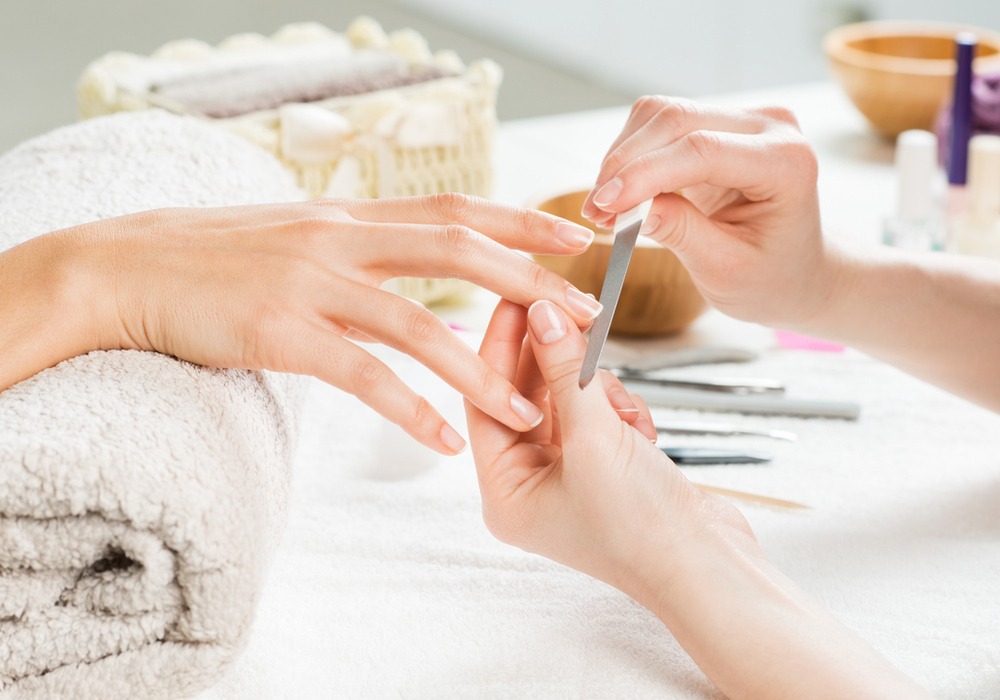Fingernails and toenails are an excellent indicator of your overall health and lifestyle. The condition of your nails can even provide a timeline of your daily habits and health history. Nails can develop ridges, spots, splits, and dents over time. Outlined below are six of the most common nails markings, their causes, and how to treat them.
Evenly-spaced vertical ridges on the nail plate are very common, especially for people over the age of 30. Ridges generally become more pronounced with age and are a result of the nail’s inability to retain moisture. In this way, you can think of ridges on your nails as wrinkles on your skin. However, if ridges appear suddenly on your nails, you may have an inflammatory skin condition such as psoriasis or alopecia (hair loss).
Solution: To smooth out the surface of the nail and minimize the appearance of ridges, gently buff the nail plate. For thin and weak nails, it’s best to leave the ridges alone or apply a ridge-filling, nail-strengthening base coat before using nail polish. If the ridges have appeared suddenly, see a doctor.
Small White Spots
Small white spots on an otherwise healthy nail are fairly common. Spots are signs of damage to the cuticle, the thin skin surrounding the base of the nail plate. The cuticle seals the nail by locking in moisture and by blocking out bacteria and drying chemicals, such as formaldehyde-infused nail polishes or acetone-based nail polish removers. Cuticles that are overly trimmed, cut, pushed, or picked at can compromise nail growth. As a result, white accumulations (punctate leukonychia) can occur in the nail plate. A minor bash to the finger can also result in small white spots on the nail.
White spots cannot be removed and are best left alone until they grow out. To prevent white spots from appearing in the future, leave your cuticles alone, use acetone-free nail polish removers, and stick with formaldehyde-free nail polishes. Within a few months, the cuticles will heal, which will allow healthy nails to grow. If a white spot isn’t disappearing after a few weeks, consult a doctor.
Splitting Nails
Weak, brittle nails can result from a dry nail plate. If the tips of your nails tend to split or break easily, an overexposure to water, detergents, and chemicals may be the reason.
For stronger, faster growing nails, make sure you get the daily recommended intake of 30 micrograms of biotin, a B vitamin found in many foods such as fish and eggs, or as a supplement. Small changes to your daily habits can also help protect your nails. For example, wear cotton-lined rubber gloves when gardening, doing chores, or washing the dishes. Instead of using dehydrating alcohol-based hand sanitizers, wash your hands with soap and follow up by applying a moisturizing hand cream to your nails and cuticles. To let your nails recover, take a periodic break from manicures. Once you resume grooming your nails, use only an acetone-free nail polish remover and apply a strengthening base coat.
Rough White Patches
If rough white patches appear on the nail plate, they are likely keratin granulations caused by wearing nail polish for too long or from using drying nail polish removers too frequently (more than three times a week). Chemicals in polishes and polish removers can dry out the nail plate and can cause keratin molecules to clump together, resulting in a white stain on the nail.
Take a break from wearing nail polish and using nail polish removers for approximately one month; this will help clear up the nail plate. To prevent the appearance of white patches in the future, leave your nails bare for a few days between manicures and pedicures.
A Deep Groove
A horizontal line, called a Beau’s line, can appear after a single traumatic event, such as illness, fever, pregnancy, or stress. Generally, the more severe the event, the more visible or deep the dent. During the traumatic event, cells stop metabolic activity which disrupts the growth of uniform nails. As a result, two to three months after the trauma, a groove or indentation can appear on the nail (or on all the nails).
A Beau’s line may take up to six months to fully grow out. To make the groove less noticeable and to smooth out the surface, you can apply a ridge-filling base coat to the nail. It is not advisable to buff the nail dent away as this will weaken the nail plate as it grows out.
Horizontal Dents
A dent or dip in the nail bed can occur if you’ve directly harmed the nail matrix (the pale half-moon at the base of the nail), such as by closing a drawer on your finger. Multiple dents along the centre of the nail can be a symptom of repetitively picking or pushing back the cuticle.
Solution: The horizontal dents will eventually grow out. Avoid picking at the cuticle to prevent future dents from forming.
The six nail conditions mentioned above are fairly easy to treat. In order to keep your nails in the best condition possible, avoiding biting and picking at them, and keep them clean and dry. If you notice dark lines, rippling, pitting, or discoloration (white, yellow, or blue nails), it could indicate an underlying medical condition and you should consult a doctor for advice and treatment. If you’re not sure what your nails are telling you, ask your healthcare provider to check them at your next visit, especially if you’ve noticed changes.
References

